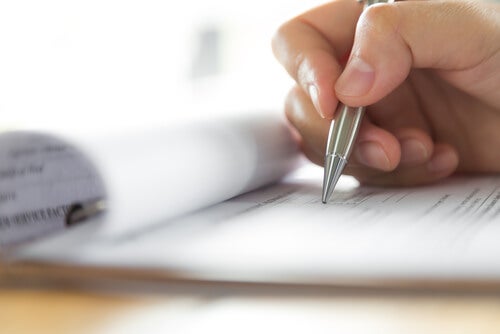The Forensic Psychology Report - How to Do One


Written and verified by the psychologist Gema Sánchez Cuevas
The forensic psychology report is a scientific and objective document that reflects the results and conclusions of an expert witness. Thus, it’s a legal document. In addition, it implies a specific responsibility and whoever draws it up may have to defend their conclusions before a Court, if necessary.
However, this defense doesn’t imply that a report may be defective. Mainly, that someone established it within the framework of some kind of judicial process. Continue reading to find out more about forensic psychological reports so you can understand them a little better.
The forensic psychology report – structure
1. General information
The formulation of the reason for the expert opinion must come from the judicial body that requests it in a clear, precise, and concrete manner. The delivery period doesn’t go into the report. However, for practical purposes, you must note it because the whole procedure depends on the time available, the evaluated person or people, and the circumstances.
For example:
PSYCHOLOGICAL REPORT Nº….
Place and date of issuance of the report: Location and date (city, month, day, and year)
Addressed to: Lawyer…, Unity, Court, etc.
Issued by: Psychologist… License Number…
Object: For example, to determine the presence of intellectual disability.

2. User identification data
This kind of report should also include basic user data. In fact, an expert opinion usually revolves around a person. However, the time needed to interview those who can provide relevant information to meet the request (the reason for the expert witness) varies. Thus, it’ll depend on professional judgment and, sometimes, on the pure and simple logic of a given case.
The forensic psychology report should include the following data:
Name and surname:
Date and place of birth:
Instruction:
Profession:
Address:
Phone:
In this example, a user and two other people will be evaluated:
- Joe Doe, 9 years old.
- Jane Doe, mother of J. Doe.
- John Doe, father of J. Doe.
3. The methodology of the forensic psychology report
Here’s a list of some of the main elements of this methodology:
Sources
- Sources are resources or means to obtain the necessary information to develop the expert opinion. Thus, they’re not part of the forensic psychological report.
- The expert witness must handle two or more hypotheses about a given case, to all of its extent and complexity. The foundation of the hypotheses is the literature, the scientific evidence on similar previous expert opinions, and the professional experience, etc. All of these are helpful for the design of this methodology. However, they don’t appear in the report.
- Some examples of sources are file, behavioral observation, interview, psychological assessment tools, etc.
Techniques and instruments
- Firstly, you must describe each one of the techniques and instruments used for obtaining information. Its usefulness in the expertise and the author or authors thereof. This way, any interested reader can consult the cited sources.
- The open interview has no author. So, if the professional designed a semi-structured interview for the occasion, it should reflect as a “semi-structured interview designed ad hoc”.
- The principle is that they must explain and justify the use of each tool, which allows others to examine the expert witness’ criteria in the selection of the most suitable tools and instruments.
4. Background of the case
This is a summary of the information that motivates the need for an expert witness. This point is vital to understand the nature of the “problem”, the relevance of the expertise, and its possible scope. This information comes mainly from the file. Family history is included in the interviews because they’re part of the results.
5. Results
Firstly, this document lists the techniques and instruments applied, following the chronological order and indicating the date and time of application. Also, the duration of the session and the results obtained without interpretation, mainly for integrating the results.
You can merge the “results and integration of results” section, and describe them in that order. Results are the specific and relevant information that responds to the purpose of the expert opinion. Thus, the type of results must correspond to what the “tools or evaluation protocol” section states. Thus, it must respect the chosen order of evaluation (child, mother, and father) and the application of the selected techniques and instruments.
Finally, the person who writes a forensic report should be careful not to give nature of truth or fact to their comments or affirmations that have no medical, legal, or administrative value or that aren’t reliably verified. In these cases, phrases such as: “In the opinion of Miss…”, “As Mr…. states”, “The document states…”, “In the words of Mrs…”, or “The child says…”.
6. Integration of the results
It consists of integrating all the relevant information obtained and finding its logic, as it’ll enable a psychologist to write conclusions consistent with the ones mentioned above.
On many occasions, the expert needs to use theoretical elements or scientific data so that the reader understands their interpretation of the results. So, if you find yourself in this position, remember to reflect the corresponding citations and include all the sources in the “references” section.

7. Forensic psychology report – conclusions
Firstly, it must contain a clear and precise answer to the questions that motivated the expert opinion, recognizing the level of objectivity and scope of the information. In any case, the best thing is for each inference in the report to have a certainty judgment. This is mainly to expose the margin of error used by the person who wrote the report.
In the conclusions of a forensic report, there are also the resources used by the expert witness. This is because, in many cases, these are associated with the margin of error mentioned above. Some of them can be time, logistic facilities, access to the necessary people, the collaboration of the users who participated in the expertise, the age or mental state of those evaluated, etc.
8. Recommendations
The author only includes them if a judicial authority requires them or if the expert witness thinks it’s necessary for the authority to become aware of them in the forensic psychological report.
However, these are usually related to treatment suggestions, new evaluations, obtaining complementary information for a better assessment of the case, useful information for the adoption of protective measures, etc.
9. References
Finally, references are also necessary for any forensic psychological report. In addition, they’re very important as they allow consultation of the theoretical, technical, and scientific sources that the expert witness used for developing and writing the report.
10. Annexes of the forensic psychology report
Sometimes, depending on the importance of a case or the complexity of the information collected, it’s a good idea to attach videos, tests, questionnaires, drawings, or documents. However, it isn’t common to attach evaluation material. This is because they’re only provided if the judge or the prosecutor formally requests it. Therefore, if they’re incorporated into the report, they must be listed as annexes and explain what each one consists of.
In conclusion, the last lines consist of a summary of the recommended sections of a forensic psychological report. So, if you’re to write one, you must always consider where the information should go, what to do with it, and how far you can infer. This is because the expert witness’ conclusions can tip the balance in the field of forensic psychology. However, the judge will always have the last say.
All cited sources were thoroughly reviewed by our team to ensure their quality, reliability, currency, and validity. The bibliography of this article was considered reliable and of academic or scientific accuracy.
- Echeburúa, Enrique, José Manuel Muñoz, and Ismael Loinaz. “La evaluación psicológica forense frente a la evaluación clínica: propuestas y retos de futuro.” International Journal of Clinical and Health Psychology 11.1 (2011).
- Tapias, A. “Psicología forense.” Tapias, A. & Gutiérrez de Piñeres, C. Psicología Jurídica: Perspectiva Latinoamericana. Bogotá (2008).
- Urra, Javier. “Dilemas éticos de los psicólogos jurídicos.” Anuario de psicología jurídica 17 (2007).
This text is provided for informational purposes only and does not replace consultation with a professional. If in doubt, consult your specialist.








